|
Lockheed P-38F/G Lightning
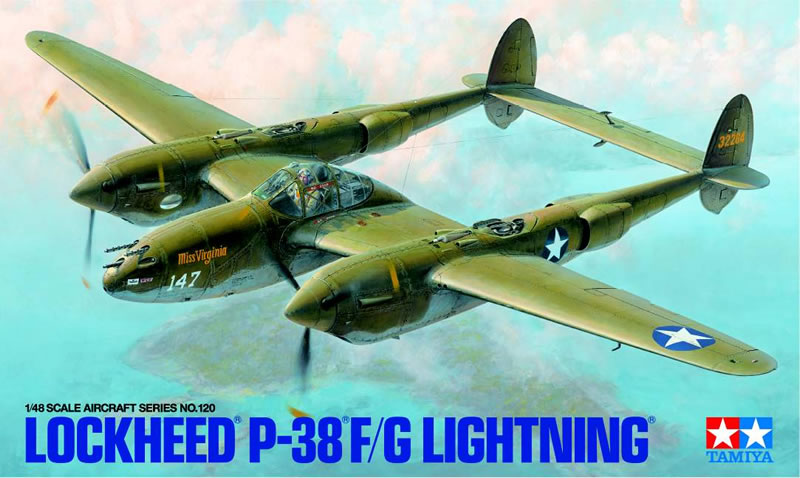
Tamiya, 1/48 scale
S
u m m a r y |
| Catalogue Number: |
Tamiya Kit No. 61120 - Lockheed P-38F/G Lightning |
| Scale: |
1/48 |
| Contents and Media: |
207 parts in grey coloured plastic; 18 parts in clear; self-adhesive canopy masks; three large chrome ball bearings; markings for two aircraft. |
| Price: |
TBA |
| Review Type: |
FirstLook |
| Advantages: |
Clever and modeller-friendly design; excellent detail throughout; crisp and restrained surface textures; useful options that will permit the F or G to be built straight from the box; nice seated pilot figure; includes self-adhesive canopy masks. |
| Disadvantages: |
|
| Conclusion: |
More than 25 years after Hasegawa launched their P-38 Lightning family, Tamiya has now released their own state-of-the-art effort.
Tamiya has once again woven its magic, this time on a subject whose forerunners from Hasegawa, Academy and Monogram have all been notoriously difficult to build.
There is nothing fancy about this kit - no engine to display, photo-etch or moving parts. What we have instead is a delightfully detailed and accurate model that will go together without any drama.
Tamiya has a happy knack for producing a kit that looks good on the sprues but gets even better when you start building it. Not for the first time during assembly, I find myself grinning at the clever choices made by Tamiya's design team, especially in the cockpit, wheel wells and the breakdown of the wings, booms and the big horizontal tailplane that precisely anchors the Lightning's complex geometry.
Detail in the wheel wells is some of the best that I have seen anywhere. The cockpit also looks significantly better assembled than it does flat on the sprues.
There are plenty of inserts but don't be alarmed - fit is perfect. You will be hard pressed to pick a join line from a recessed panel line.
Tamiya's brand new 1/48 scale P-38F/G Lightning is a worthy replica of this beautiful aeroplane. You can be confident that the kit will line up perfectly and fit together without any resistance too! |
Reviewed by Brett Green

Eduard's re-tooled 1/48 scale Messerschmitt Bf 109 G-6 will be available online from Squadron.com
Background
The Lockheed P-38 Lightning is a American World War II two-engined fighter aircraft.
Developed for the United States Army Air Corps, the P-38 had distinctive twin booms and a central nacelle containing the cockpit and armament.
Allied propaganda claimed it had been nicknamed the fork-tailed devil (German: der Gabelschwanz-Teufel) by the Luftwaffe and "two planes, one pilot" by the Japanese.
The P-38 was used for interception, dive bombing, level bombing, ground attack, night fighting, photo reconnaissance, radar and visual pathfinding for bombers and evacuation missions, and extensively as a long-range escort fighter when equipped with drop tanks under its wings.
The P-38 was used most successfully in the Pacific Theater of Operations and the China-Burma-India Theater of Operations as the aircraft of America's top aces, Richard Bong (40 victories), Thomas McGuire (38 victories) and Charles H. MacDonald (27 victories).
In the South West Pacific theater, the P-38 was the primary long-range fighter of United States Army Air Forces until the appearance of large numbers of P-51D Mustangs toward the end of the war.
The P-38 was unusually quiet for a fighter, since the exhaust was muffled by the turbo-superchargers. It was extremely forgiving and could be mishandled in many ways but the rate of roll in the early versions was too low for it to excel as a dogfighter.
The P-38 was the only American fighter aircraft in large-scale production throughout American involvement in the war, from Pearl Harbor to Victory over Japan Day.
At the end of the war, orders for 1,887 more were cancelled.*
The P-38 Lightning in 1/48 scale
There has been no shortgage of 1/48 scale P-38 Lightning kits over the last six decades.
Monogram released their initial 1/48 scale P-38 Lightning kit in 1964. That makes it nearly as old as I am! This was hailed as a great kit in its day, but time has taken its toll on the mouldings. Even so, it is still widely available and is ocassionally re-released.
Hasegawa's debut 1/48 scale P-38J Lightning was launched in 1993 - more than 25 years ago. This was a good kit for its day but it quickly earned a reputation for being diffcult to build, especially aligning the booms and wings.
Academy was up next in the very same year with their 1/48 scale Lightning. Detail was not up to the same standard as Hasegawa and once again it proved to be a difficult kit to build.
Both Hasegawa and Academy eventually released a wide range of variants from the P-38E to the P-38L and most of the family in between.
Minicraft also released several 1/48 scale P-38 variants. I recall at the time that there was some confusion about whether these were an original kits or re-pops of the Academy Lightnings, and I'm still sure of the final conclusion.
In 2014, Hobby Boss broke the Lightning drought with a new 1/48 scale kit. Sadly, despite clever enginering for assembly of the main parts, that kit suffered from a long list of inaccuracies and shortcomings. Check out Lynn Ritger's review on HyperScale for full details.
Regardless, it is now more than a quarter of a century since Hasegawa released 1/48 scale Lightning kit; and those currenty on the market are challenging to build, to say the least, or deeply flawed.
I have never built Hasegawa's or Academy's 1/48 scale Lightning kits due to their widespread reputation for difficult alignment and poor fit.
Let's see if Tamiya changes that.
Tamiya's brand new 1/48 scale Lightning kit may be built as a P-38F or a P-38G straight from the box.
The kit comprises 207 parts in grey coloured plastic, 18 parts in clear, self-adhesive canopy masks, three large chrome ball bearings and markings for two aircraft.
Please note that the sample I am reviewing is a pre-production test shot in a plain white box. I expect that the sprues in the production kit will be moulded in Tamiya's classic darker grey plastic.
Surface texture is everything we would expect to see on a Tamiya 1/48 scale new release - crisp and subtly recessed panel lines with some selected rivets as appropriate.
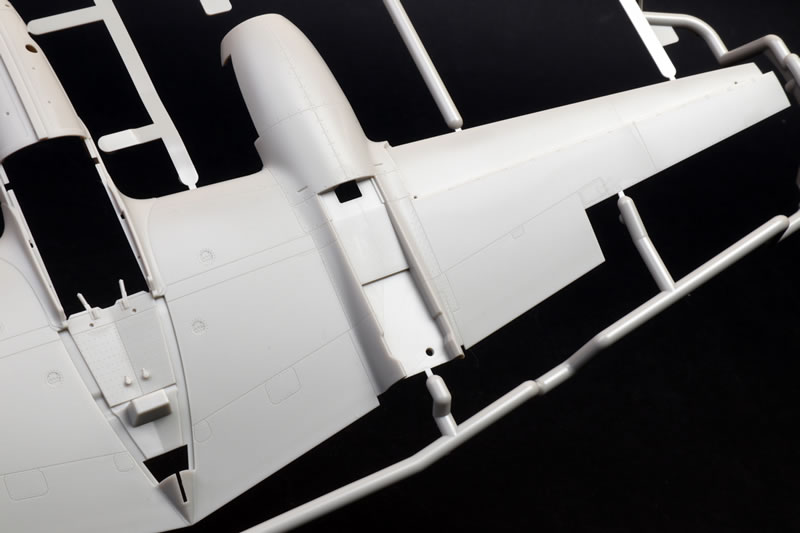
Options include alternative parts in the cockpit, turbo-supercharger, stores and more that allow either the P-38F or G to be built. Ferry tanks and standard Lockheed drop tanks are also included.
Parts breakdown reflects the unusual configuration of the aircraft and appear to be designed to ensure precise alignment. The upper wings and the top of the centreline fuselage pod are moulded as a single full span part. The entire nose in front of the windscreen is designed to be covered by two parts over the top and the sides.
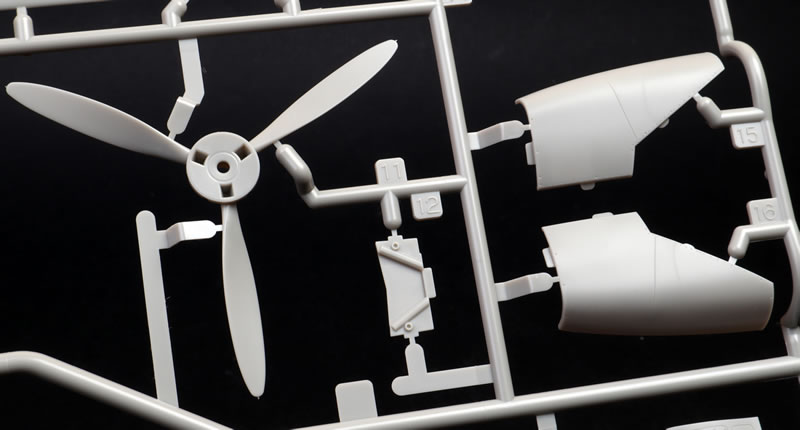
This makes it possible for Tamiya to introduce other types including the F-4 and F-5 photo-reconaissance variants.
The lower half of the fuselage pod is moulded with the inboard lower wing secttons.

A long wing spar extends either side of the roof of the nose wheel well. This will ensure perfect dihedral.

Cockpit detail is very good. Decals are supplied for the instrument panel. These align perfectly over the raised instrument bezels. Two different styles of instrument panel are provided for the P-38F and G.

A nicely sculpted seated pilot figure is offered as an option for the cockpit.
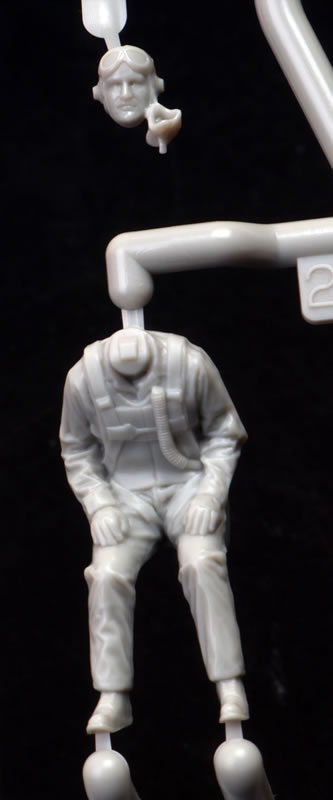
The assembled cockpit will be trapped between the upper and lower fuselage pods. The first of the three large chrome ball bearings is also fitted between the pod halves as nose weight.
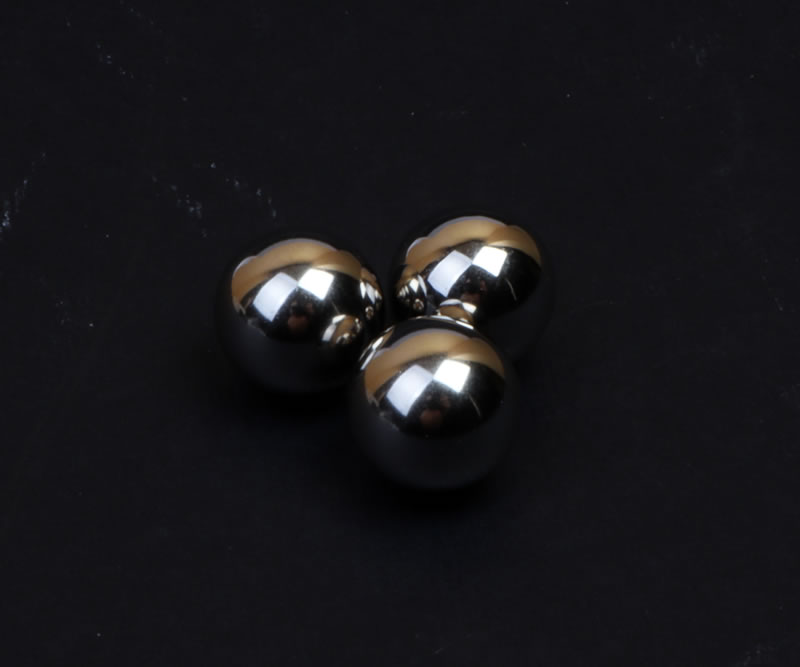
Tamiya has moulded the wings with wide separate leading edge inserts. These will permit later variants with leading edge landing lights.
Two styles of turbo-supercharger are supplied for the F and G.
The wheel wells are busy with plumbing, rivets and other structural features. The completed wheel wells along with the other two nose weights are fitted between the boom halves. Interestingly, Tamiya has supplied the mesh boom intake grilles as decals.
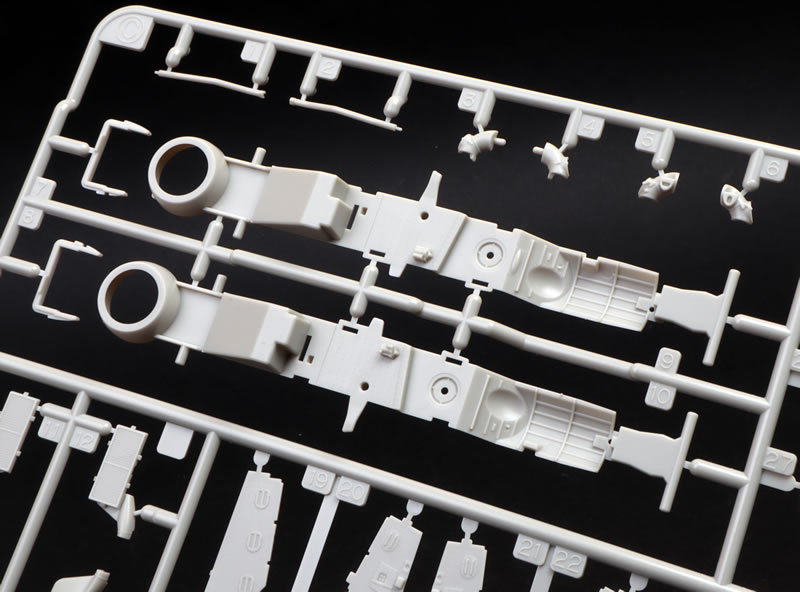
The completed booms are glued to the bottom of the engine nacelles and are locked into place with the large, one-piece horizontal tail surfaces (Part B7).
The booms are moulded with separate inserts at the bottom cowling area and a cover at the top, suggesting that we might see later variants such as the P-38J and L from Tamiya in the future.
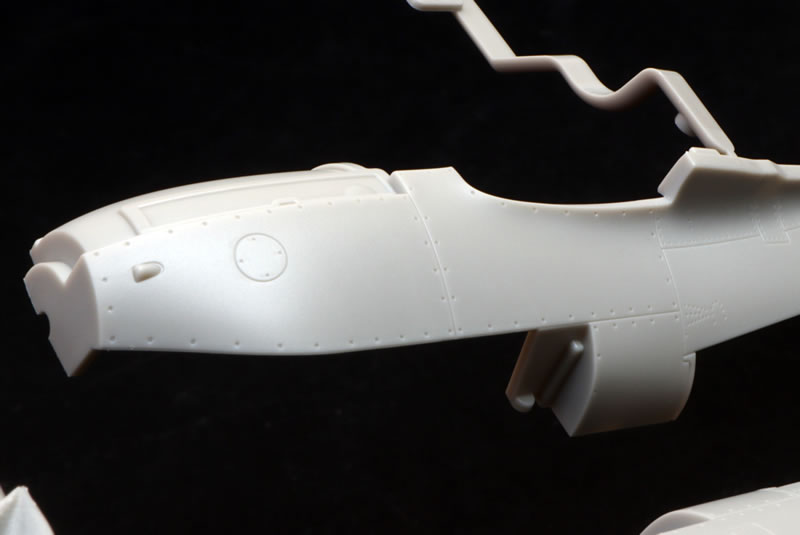
Two styles of main wheel are offered - covered and spoked. The wheels are supplied in two halves each and they are neither bulged nor flattened.
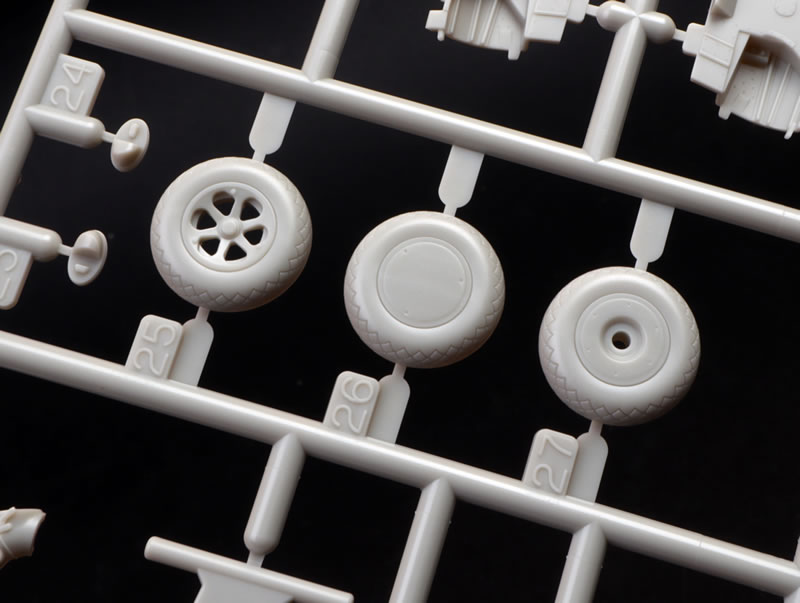
Landing gear doors have been a commmon factor of frustration for those building the Hasegawa and Academy kits. Tamiya has addressed this challenge by moulding a mounting rail onto the hinges and doors, ensuring an easy and robust fit.

The crew boarding ladder may be built deployed or stowed.
The pilot's seat and the radio gear on the rear deck are fitted very late in construction. This is a good idea as they would risk being damaged or knocked off during assembly. I'll probably wait until I have finished painting the model until I install these. Decals are supplied for the pilot's harness.
The counter rotating propellers are correctly depicted. Make sure you attach these to the correct sides!
Canopy parts are thin and clear. Two styles of canopy are included, and they both may be posed open or closed. Both canopies feature the framed rear section.
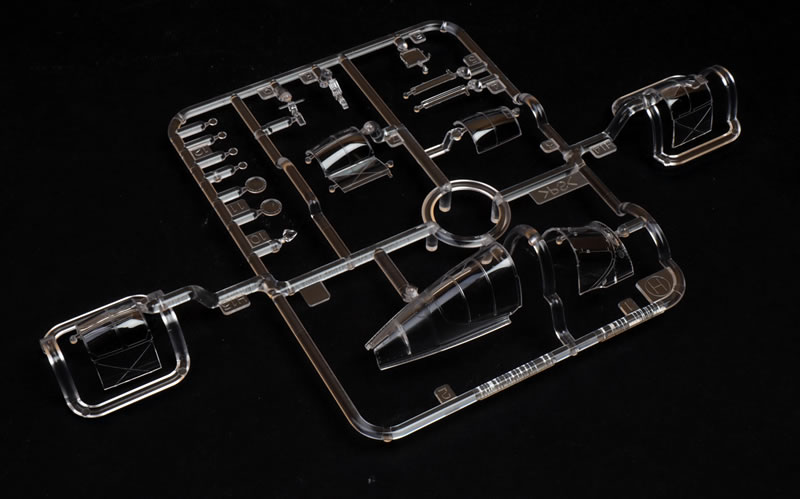
Self adhesive masks are provided for the canopy.
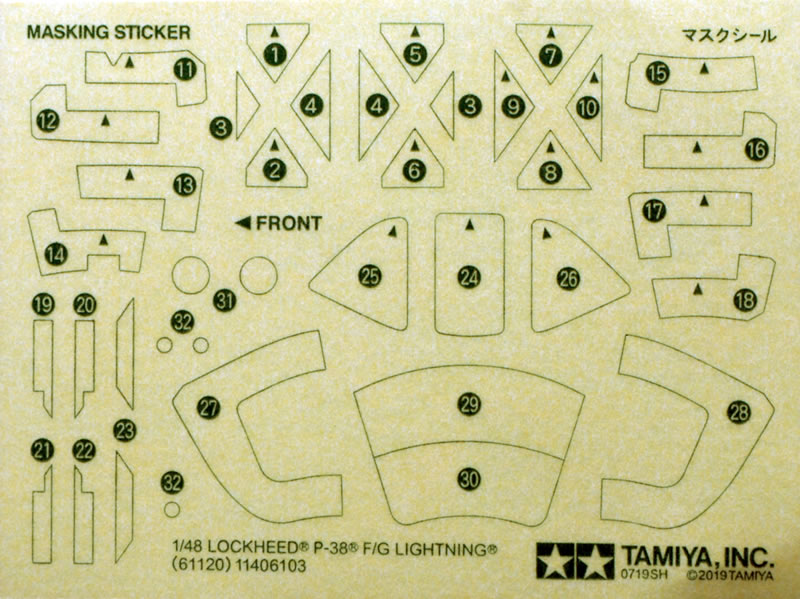
As is usual with Tamiya masks, the outlines are printed onto the Kabuki-tape masks and the modeller is required to cut out the shapes. I used a sharp hobby knife on mine and had no problems at all.
Markings
Markings are supplied for two aircraft:
-
P-38G Lightning - White 147 of 339th FS, 347th FG, 13th Air Force, Operation Vengeance (attack on Admiral Yamamoto's aircraft based on Guadacanal in April 1943
-
P-38F - White 33, 39th FS,m35th FG, 5th Air Force, Port Moresby, late 1942. This aircraft features sharks mouths and eyes on the engine nacelles.
Both aircraft are finished in the early scheme of Neutral Grey lower surfaces and Olive Drab upper surfaces. Full colour, double-sided A3 marking guides are suppied for each aircraft.
Nice shiny mirror decals are supplied on the sheet, including the unique oval mirrors on the lower inboard enegine nacelles. Nice touch.
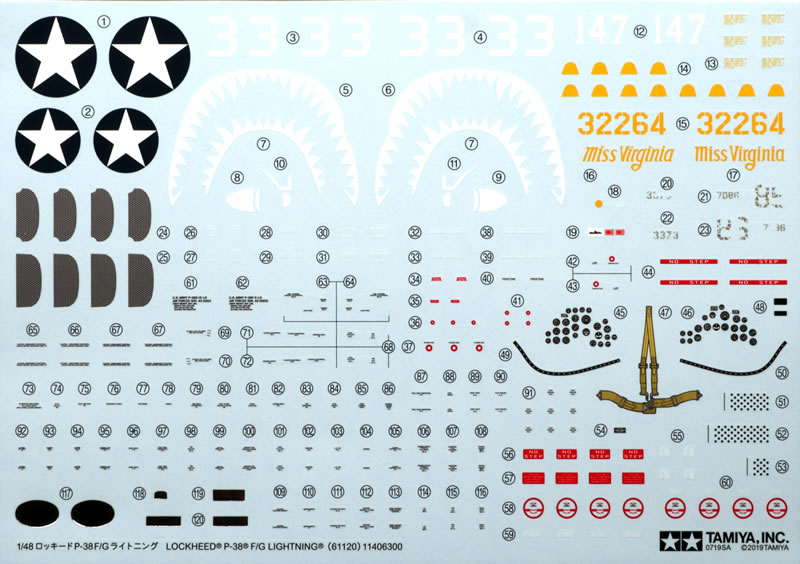
Printing, colours and registration is perfect on my sample.
More than 25 years after Hasegawa launched their P-38 Lightning family, Tamiya has now released their own state-of-the-art effort.
Tamiya has once again woven its magic, this time on a subject whose forerunners from Hasegawa, Academy and Monogram have all been notoriously difficult to build.
There is nothing fancy about Tamiya's Lightning - no engine to display, photo-etch or moving parts. What we have instead is a delightfully detailed and accurate model that will go together without any drama.
Tamiya has a happy knack for producing a kit that looks good on the sprues but gets even better when you start building it. Not for the first time during assembly, I find myself grinning at the clever choices made by Tamiya's design team, especially in the cockpit, wheel wells and the breakdown of the wings, booms and the big horizontal tailplane that precisely anchors the Lightning's complex geometry.
Detail in the wheel wells is some of the best that I have seen anywhere. The cockpit also looks significantly better assembled than it does flat on the sprues.
There are plenty of inserts but don't be alarmed - fit is perfect. You will be hard pressed to pick a join line from a recessed panel line.
Tamiya's brand new 1/48 scale P-38F/G Lightning is a worthy replica of this beautiful aeroplane. You can be confident that the kit will line up perfectly and fit together without any resistance too!
* Historical text adapted from Wikipedia
Thanks to Tamiya for the sample
Review Text Copyright © 2019 by
Brett Green
Page Created 7 August, 2019
Last updated
8 August, 2019
Back to HyperScale Main Page
Back to Reviews Page |
